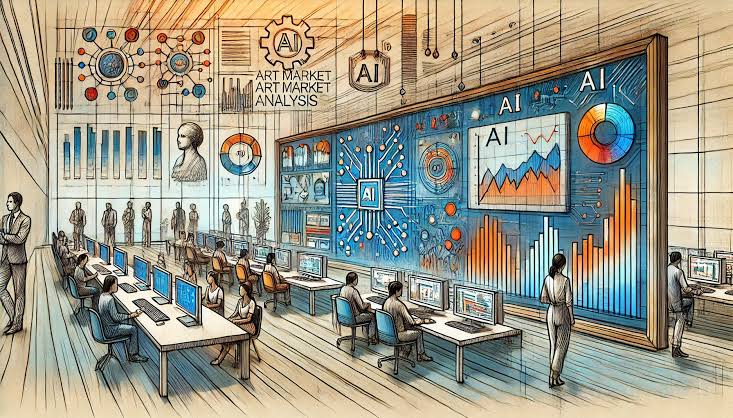"Explore the business of AI art, including current market trends, emerging opportunities, and challenges. Learn how AI is transforming the art world, driving commercialization, and creating new possibilities for artists, investors, and technology companies."
The AI Art Industry: Trends and Opportunities
Artificial Intelligence (AI) has made progress, across fields and its fascinating application lies in the world of art. AI generated artwork, produced through algorithms and machine learning is not reshaping ideas of creativity but also paving the way, for new possibilities in the art market. In this article we delve into the trends and prospects within the AI art business exploring how technology is revolutionizing the art scene its economic implications and potential future developments.
Understanding AI Art
AI art refers to the use of intelligence algorithms to produce artworks. These algorithms can create images, paintings and various art forms by learning from existing datasets or following programmed instructions. Commonly employed models like Generative Adversarial Networks (GANs) and neural networks are used to generate art. They can yield results that blend human and machine creativity. AI art goes beyond visual representations. It encompasses installations, design and multimedia applications. The emergence of AI art showcases evolving intersection of technology and creativity blurring the lines between content generated by humans.
Market Trends in AI Art
The market for AI generated art is experiencing growth fueled by trends. One notable trend is the increasing acceptance and integration of AI art into galleries and exhibitions. Traditionally art has been defined by creativity but AI art challenges these norms by introducing forms of creativity driven by algorithms. This recognition is leading to AI art gaining prominence in renowned institutions, auction houses and art fairs.
Another significant trend is the commercialization of AI art. AI generated artwork is being sold at auctions and through platforms. Notable examples include pieces by AI artists like Obvious and Artbreeder, which have attracted attention and sales. These transactions indicate a growing interest in AI art among collectors and investors who are exploring its potential as both a creative and financial asset.
Another significant trend is the increasing accessibility of art creation. AI tools are now available to people enabling aspiring artists and art lovers to explore AI generated artwork. User friendly platforms such as Runway ML and DeepArt simplify the process of creating AI art making it approachable for those lacking technical skills. This broader accessibility is spreading the popularity of AI art and encouraging a variety of creative forms.
Opportunities in the AI Art Market
The realm of AI art business offers a range of opportunities, for artists, investors and tech companies. Artists can explore horizons and experiment with tools by harnessing AI algorithms to discover styles, create intricate patterns and develop interactive installations that challenge art conventions. This paves the way, for creativity and collaboration between humans and machines.
For investors and collectors AI art emerges as a promising asset class with potential. With the expanding AI art market there are chances to invest in AI generated artworks both as standalone pieces and within larger collections. The distinctiveness of art coupled with its growing recognition and acceptance makes it an appealing investment choice, for those seeking to diversify their portfolios and seize emerging trends in the art industry.
The surge in AI art is proving advantageous, for tech firms. Those working on AI art tools and platforms have a chance to tap into this expanding market by providing creative solutions for making, showcasing and distributing art. Collaborations with artists, galleries and organizations can boost their visibility in the market and fuel progress in this field.
Challenges and Considerations
In spite of the opportunities in the AI art industry there are obstacles and considerations that require attention. One such challenge revolves around issues of authorship and originality. The emergence of art prompts discussions about ownership rights over pieces created by algorithms—whether they belong to the human programmer who designed the AI the AI itself or the company behind the technology. Ongoing debates surrounding these questions could impact the legal and ethical dimensions of AI art.
Additionally there is a risk that AI art may remain a niche market. Although gaining popularity AI art is still in stages of development. Its future success as a recognized genre will hinge on its ability to connect with audiences and establish enduring cultural and artistic relevance.
The nature of AI art brings about difficulties, in terms of inclusivity and accessibility. Although AI art tools are becoming easier to use there is still work to be done to ensure that these tools are available to a variety of artists and creators. It's crucial to keep AI art an inclusive and welcoming space for its growth and acceptance.
Future Prospects
Looking ahead the field of AI art is set, for growth and innovation. Advancements in technology like enhanced algorithms and machine learning models are expected to result in more advanced and imaginative AI generated artwork. As technology progresses AI art may find applications in aspects of life ranging from engaging digital art installations to tailored art experiences.
The expansion of AI art into formats and mediums will also fuel its development. For instance AI art could be utilized in reality and augmented reality settings creating captivating and interactive artistic atmospheres. Moreover partnerships between AI creators and traditional artists could give rise to exciting hybrid art forms that blend creativity with algorithmic accuracy.
To sum up the AI art industry is a dynamic and fast progressing domain that presents a range of opportunities for artists, investors and tech firms. With its increasing acknowledgment and acceptance AI art is revolutionizing the realm of creativity and fostering innovation. As the market evolves it will be crucial to tackle the challenges and factors related to AI art while also embracing its potential to reshape the future of artistry and imagination.
